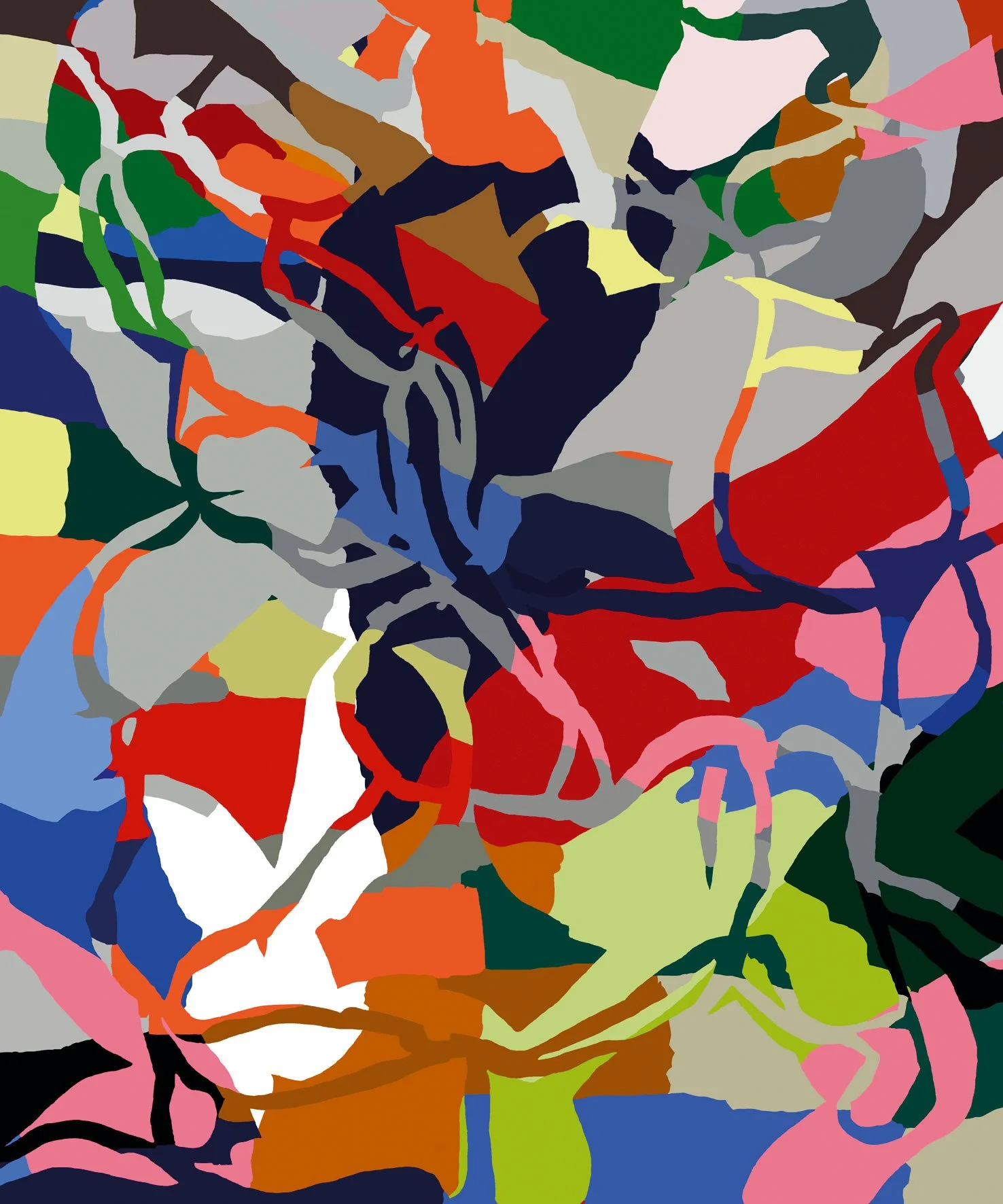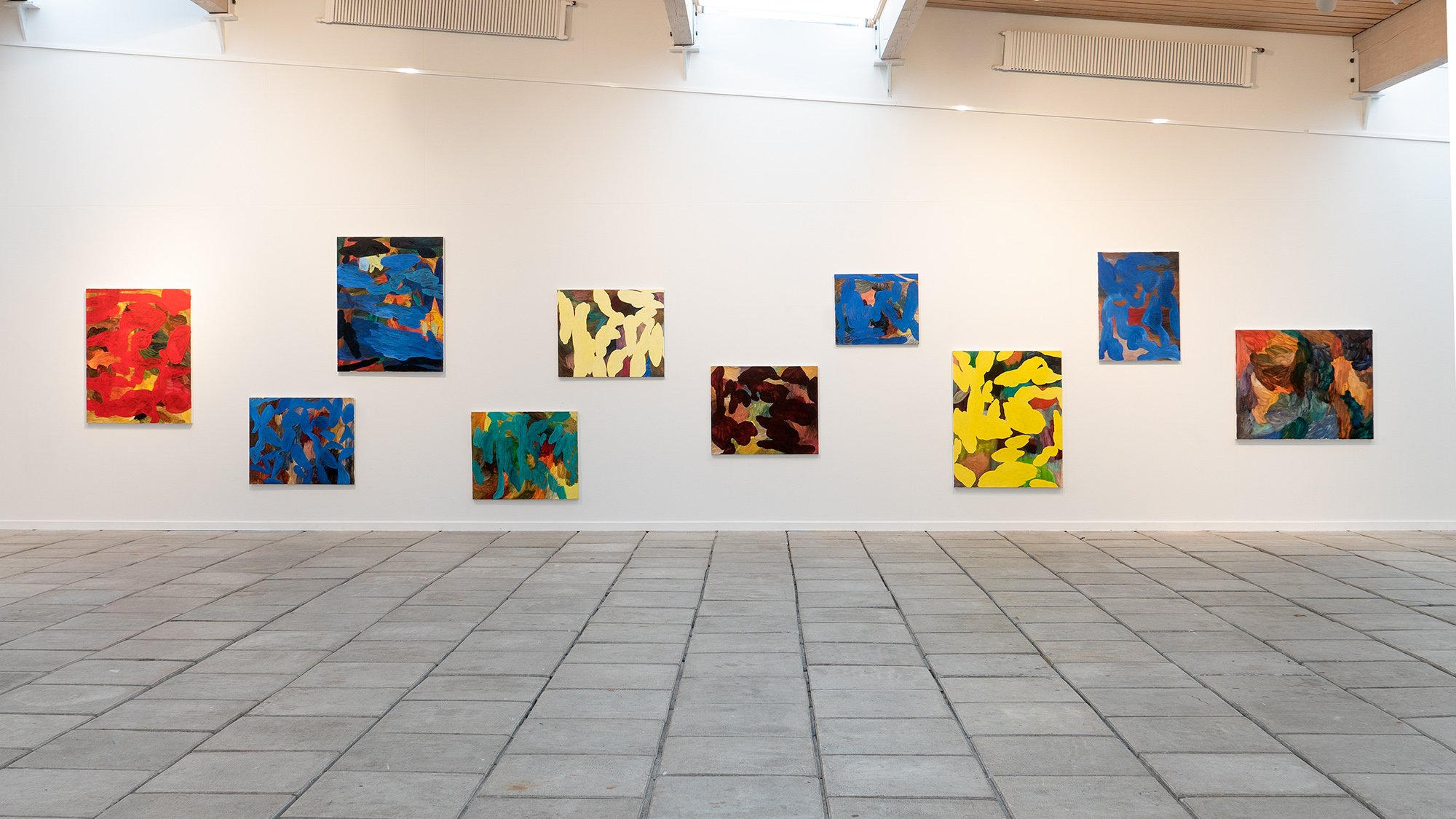Where the Coordinates Intersect
by Nils Ohrt
“Gazing Through Skin”, oil on canvas, 100 x 80 cm, 2017
What would we see if we could look through skin? Blood. That would be most people’s answer. If the title is anything to go by, it might also be the flow of blood that we see in Bjarne Werner Sørensen’s painting, Gazing Through Skin (2017), which features on the cover of this catalogue.
If it is blood, however, it is not an unambiguous reference. The red colour is thinly applied and its soft, undulating patterns are rather reminiscent of a cloud system, which, like an expansive, irregular arabesque is about to spread across the sky. The sensation of floating clouds is also accentuated by the fact that, in the openings between them, sections of a universe emerge: something between a dark brown, dark green landscape and a bright yellow sky.
However, the blood, the clouds or whatever other associations Bjarne Werner Sørensen’s painting might invoke are subordinate to an abstract, or rather non-figurative composition, since there are no visible references to reality. The only thing we can say with certainty is that the painting depicts motion and weightlessness in a purely pictorial space.
“Falling Upwards”, oil on canvas, 80 x 60 cm, 2017
This occurs in varying degrees of figuration, in which relatively defined silhouettes float over the more diffuse universe of the background. The airy dynamics are also expressed in different ways. The movement of the red silhouettes in the foreground are circumscribed by undulating contours. Conversely, energetic brush strokes of the thin colour create life and movement in the formless background. Nevertheless, the same dynamic animates both spheres, because the red colour is so thin that the strokes beneath it penetrate it like modulating shadows. The background thus serves as a bass line or lower voice in the picture’s fugue of colour.
Nonetheless, even though this is a non-figurative painting, Bjarne Werner Sørensen chose to give it a title, thereby putting words to something inexpressible. But a title such as Gazing Through Skin was not something that was in place from the start. It evolved as the painting was being created. Whenever Bjarne Werner Sørensen is working on a painting, he writes down in a notebook any words or ideas that occur to him along the way. When the picture is complete, he consults his notes and the title emerges as a poetic association.
“Collapse”, acrylic on canvas, 120 x 100 cm, 2006.
The National Gallery of the Faroe Islands
This dialogue between picture and words is a typical approach for Bjarne Werner Sørensen. His insistance on giving his pictures titles means that he also acknowledges that language is a key element, if art is to communicate. The title opens the door to a conscious process in the viewer, but the moment we step inside there are several corridors to walk down.
A title such as Gazing Through Skin is an open, poetic association. This has much to do with Bjarne Werner Sørensen’s consistent use of English when giving his pictures names. As a child he attended an American kindergarten and spoke the language fluently. However, for the artist English has different sound associations from his everyday Danish. That means that, rather like poetry and music, the sounds of the foreign language are more independent in relation to the content. At the same time, Bjarne Werner Sørensen’s use of English also indicates the international context to which art belongs, now more than ever before.
Gazing Through Skin features in an exhibition spanning the last 20 years of Bjarne Werner Sørensen’s art and his use of diverse media. The way the exhibition pans across this period also formed the basis for the title the artist chose for his exhibition: Kringsýni, a made-up Faroese word. It means ‘looking around, letting your gaze drift from one thing to another” and suggests the artist’s need to take stock. But Kringsýni is also an invitation to visitors to view the exhibition as variations on an overall theme. This is also reflected in the fact that it was the artist himself who planned the presentation so meticulously.
“Parameter Morphing”. Oil on canvas, 152 x 122 cm, 2017
When speaking about his art, Bjarne Werner Sørensen uses the expression “coordinates”: a reference to the axes of experiences and influences, within which his art takes shape. In a work such as Gazing Through Skin the most obvious axis of this coordinate system is post-war Abstract Expressionism: particularly the Natural Romantic version evident in the works of Per Kirkeby (1938-2018). Even though the dancing silhouettes on the surface are very different, his older colleague’s attitude to colour and brush work are not far off in Bjarne Werner Sørensen’s latest paintings. When it comes to his digitally produced graphics, the linear arabesques of Brice Marden (b. 1938) constitute an art historical reference in a similar way. Like the American, Bjarne Werner Sørensen is also fascinated by traditional East Asian calligraphy or pencil writing.
The artist also acknowledges his passion for Kirkeby and Marden, and can even point to other sources of inspiration. Naturally these various influences are relevant, but the question is how significant they are today. What was once referred to as ‘eclecticism’ has become the name of the game in contemporary art, where all the world is its stage and where all the various and sundry expressions make it well nigh impossible to come up with new, unseen ones. It is of course also as a consequence of this that classic modern art and modernism’s demand for new, shocking agendas have now been ousted by Postmodernism’s less ambitious approach: to create an independent expression, deploying both contemporary and historical art.
“Dust”, archival pigment print on Somerset 300 gsm paper, 163 x 130 cm, 2005. The National Gallery of the Faroe Islands
Another axis in the coordinate system that frames Bjarne Werner Sørensen’s art is music. In fact, listening to jazz-rock fusion bands such as Weather Report in his early youth actually prompted his decision to become an artist. What thrilled the teenage Sørensen was music as a meditative journey into an unknown country, and it was that narrative to which he wanted to give visual form. At the same time, the gradual continuum of shapes and lines in Bjarne Werner Sørensen’s art is a response, not only to jazz-rock, but also to the fundamental essence of music in general: in the sense of a pattern of sounds expressed in time. Electronic music has been a particularly important source of inspiration for his art: especially the rhythmic patterns of techno music, which can be repeated, varied and mirrored in countless ways. The works of Bjarne Werner Sørensen also have another relation to electronic music. His ink-jet graphics are also produced on a computer.
Yet another important axis in the Bjarne Werner Sørensen coordinate system is the nature of the Faroe Islands. His mother is Faroese, and as a child he spent many of his summer holidays with his family exploring the Faroe Islands. In particular, he spent a lot of time in his grandparents’ house in the village of Froðba on Suðuroy: a house he now jointly owns. The young man’s participation in working life on the farms even involved having his manhood put to the test in the true-blue Faroese way. At the age of 17, during a year-long stay on the Islands, he worked on a fishing boat in the North Atlantic.
“From Spring Till Fall”, 560 photos, 1996
The fact that the life and landscape of the Faroe Islands are deeply embedded in Bjarne Werner Sørensen can be witnessed in a photo installation in the exhibition, featuring an impressive 560 photos from the spring to the summer and autumn of 1996. This does not mean that the Faroe Islands and the landscape are literally present in his work, even though it is certainly tempting to see both whaling and mountain gorges in Gazing Through Skin! No. The mature art of Bjarne Werner Sørensen is all about structures, perpendicularity and movement. Another quality is the infinity of horizon-less weightlessness, which you experience standing on the edge of the sheer Faroese cliffs.
In other words, the Faroese landscape, including the man-made landscape, is subject to an extreme degree of abstraction in Bjarne Werner Sørensen’s art. Along with the inspiration from music and contemporary art, this cleansing and processing of the visible world are part of a personal expression that constitutes an inner landscape. Although the artist’s psyche is inevitably present here, it is not the main issue. It is the art’s mental image of freedom, beauty and power.
Nils Ohrt is an art historian and former director of The National Gallery of the Faroe Islands /Listasavn Føroya
Kringsýni, solo exhibition by Bjarne Werner Sørensen
The National Gallery of the Faroe Islands
September 14, 2018 - January 13, 2019
Kringsýni
The title of this exhibition at The National Gallery of the Faroe Islands , Kringsýni, is a made-up Faroese word by the artist. It means ‘looking around, letting your gaze drift from one thing to another, and suggests the artist’s need to take stock.

